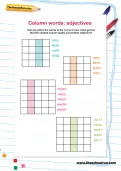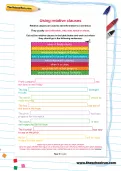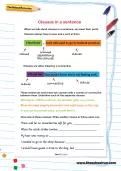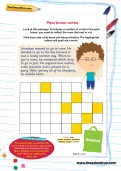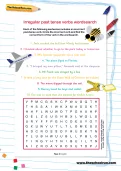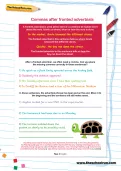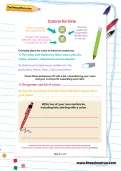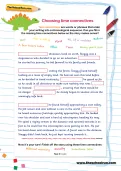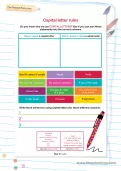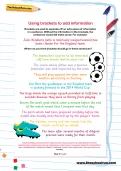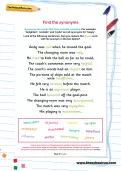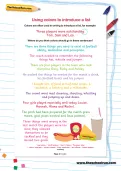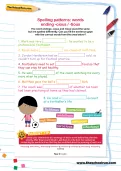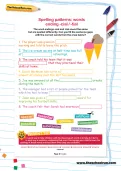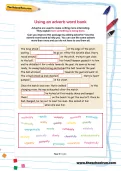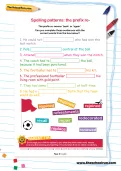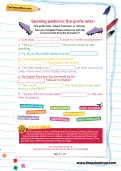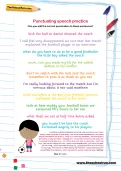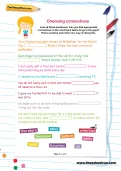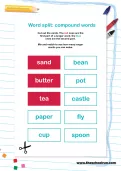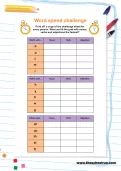Look at this passage. It includes a number of verbs in the past tense; you need to collect the ones that end in -ed. Find them and write them into the grid below. The highlighted letters will spell out a word.
or
Register to add to your saved resources
Already a subscriber? to view this content.
A fun and free activity created by an experienced teacher with the aim of teaching KS2 children about irregular past tense verbs. Each of the sentences on the worksheet includes an incorrect past-tense verb. Circle the incorrect verb and then find the correct form of the verb in the wordsearch.
or
Register to add to your saved resources
A fronted adverbial is used at the start of a sentence to explain more about the verb. It tells us where, when or how the verb is done. After a fronted adverbial, we often need a comma. Can you place the missing commas correctly in these sentences?
or
Register to add to your saved resources
Already a subscriber? to view this content.
Can you correctly place the colon in these two sentences then finish these sentences off with a list, remembering your colon and your commas for separating each item.
or
Register to add to your saved resources
Already a subscriber? to view this content.
Time connectives are words or phrases that order your writing into a chronological sequence. Can you fill in the missing time connectives below so the story makes sense?
or
Register to add to your saved resources
Already a subscriber? to view this content.
Do you know why we use capital letters? See if you can sort these statements into the correct columns.
or
Register to add to your saved resources
Already a subscriber? to view this content.
Brackets are used to separate off an extra piece of information in a sentence. Without the information in the brackets, the sentences would still make sense. Where do you think brackets should go in these sentences?
or
Register to add to your saved resources
Synonyms are words that have a similar meaning. For example: ‘delighted’, ‘ecstatic’ and ‘joyful’ are all synonyms for ‘happy’. Look at the following sentences. Can you replace the green word with its synonym in the box below?
or
Register to add to your saved resources
Already a subscriber? to view this content.
Relative clauses are used to add information to a sentence. They usually start with when, who, that, which or whose. In this teacher-created worksheet for primary school children, you will need to cut out the relative clauses in the table and work out where they should go in the sentences.
or
Register to add to your saved resources
Colons are often used in writing to introduce a list. Where do you think colons should go in these sentences?
or
Register to add to your saved resources
Already a subscriber? to view this content.
The word endings -cious and -tious sound the same but are spelled differently. Can you fill the sentence gaps with the correct words from the ones below?
or
Register to add to your saved resources
Already a subscriber? to view this content.
The word endings -cial and -tial sound the same but are spelled differently. Can you fill the sentence gaps with the correct words from the ones below?
or
Register to add to your saved resources
Already a subscriber? to view this content.
Adverbs are used to make writing more interesting. They explain how something is being done. Can you improve this passage by adding adverbs?
or
Register to add to your saved resources
Already a subscriber? to view this content.
The prefix re- means ‘back’ or ‘again’. Can you complete these sentences with the correct words from the box?
or
Register to add to your saved resources
Already a subscriber? to view this content.
The prefix inter- means ‘between’ or ‘among’. Can you complete these sentences with the correct words from the box?
or
Register to add to your saved resources
Already a subscriber? to view this content.
Can you add the correct punctuation to these sentences?
or
Register to add to your saved resources
Already a subscriber? to view this content.
A teacher-created, fronted adverbial worksheet that provides an explanation of what a fronted adverbial is, with examples and a football-themed activity. Cut out these parts of sentences. Can you match the fronted adverbial to the correct sentence ending?
or
Register to add to your saved resources
Look at these sentences. Can you find appropriate connectives in the word bank below to go in the gaps?
or
Register to add to your saved resources
Already a subscriber? to view this content.
A mix and match puzzle created by teachers, using compound words, to support primary school literacy and demonstrate examples of compound words.
or
Register to add to your saved resources
Print off a copy of the challenge sheet for every person. Who can fill the grid with nouns, verbs and adjectives the fastest?
or
Register to add to your saved resources
Already a subscriber? to view this content.

